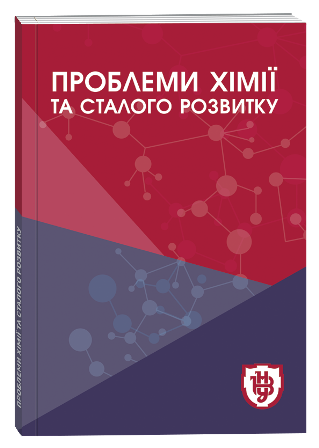IRON CARBON NANOCOMPOSITES BASED ON SYNTHETIC HUMIC SUBSTANCES AND THEIR MAGNETIC PROPERTIES
DOI:
https://doi.org/10.32782/pcsd-2022-1-5Keywords:
synthetic humates, iron, nanocomposites, pyrolysis, amorphous carbonAbstract
Metal nanoparticles encapsulated in a carbon matrix are of considerable interest in connection with the prospects for their use in the creation of new materials for technology and medicine. Metal-carbon nanocomposites containing transition metal nanoparticles are of great importance for industry. The aim of the work is the synthesis of an ironcarbon nanocomposite using synthetic humic substances as a source of carbon and studying the properties of the resulting product. The iron-carbon nanocomposite was obtained by ferum(III) humate pyrolysis in an H2 hydrogen atmosphere. The ferum(III) humate used in the work was obtained by precipitation from a synthetic sodium humate solution by Fe3+ ions. The resulting FeC nanocomposite is described by X-ray diffraction, X-ray fluorescence analysis, and scanning electron microscopy. It has been established that the resulting iron-carbon nanocomposite contains metallic iron with fcc and bcc lattices. It is shown that the average particle size in the pyrolysis temperature range of 300-1000 ºС varies from 9.8 to 52.5 nm. The mass fraction of iron in the composite increases from 29 to 41% with an increase in the synthesis temperature. The study of the magnetic properties of the obtained nanocomposites made it possible to establish that in the temperature range below 320 K they exhibit ferromagnetism, and in the range of 320 K they undergo a transition to the superparamagnetic state. The important result of the study is the dependence of the specific magnetization of the samples on the iron content and nanoparticle sizes, which makes it possible to control the magnetic characteristics when changing the synthesis parameters.
References
Al-Salih M., Samsudin S., Arshad S.S. Synthesis and characterizations iron oxide carbon nanotubes nanocomposite by laser ablation for anti-microbial applications. J Genet Eng Biotechnol. 2021. 18;19(1). Р. 76.
Bagheri M., Jafari S. M., Eikani M. H. Ultrasonic-assisted production of zero-valent iron-decorated graphene oxide/activated carbon nanocomposites: Chemical transformation and structural evolution. Materials Science and Engineering: C. 2021. 118. Р. 111362.
Bruk M. A., Zhikharev E. N., Grigoriev E. I., Spirin A. V., Kalnov V. A., Kardash I. E. Electron-beam-induced deposition of iron carbon nanostructures from iron dodecacarbonyl vapor. Micro- and Nanoelectronics. 2003. 5401. pp. 1–6.
Defilippi C., Mukadam M. O. A., Nicolae S. A., Lees M. R., Giordano C. Iron Carbide@Carbon Nanocomposites: A Tool Box of Functional Materials. Materials. 2019. 12. 323 p.
Fleaca C., Morjan I., Alexandrescu М, Dumitrache F., Soare I., Gavrila-Florescu L., Le Normand F., Faerber J. Carbon nanostructures from FeC nanocomposites by activated CVD methods. Phys. Status Solidi C. 2010. 7 (3–4). pp. 1269–1273.
Gu Z., Zhang B., Asakura Y., Tsukuda S., Kato H., Kakihana M., Yin S. Alkali-assisted hydro-thermal preparation of g-C3N4/rGO nanocomposites with highly enhanced photocatalytic NOx removal ac-tivity. Appl. Surf. Sci. 2020. 521. Р. 146213.
Herrmann I.K., Grass R.N., Stark W.J. High-strength metal nanomagnets for diagnostics and medicine: carbon shells allow long-term stability and reliable linker chemistry. Nanomedicine. 2009. 4(7). Р. 787-98.
Litvin V.A., Abi Njoh R. Quercetin as a precursor in the synthesis of analogues of fulvicacids and their antibacterial properties. Voprosy khimii i khimicheskoi tekhnologii. 2021. 2. рp. 56–64
Litvin V.A., Abi Njoh R. Сopper-carbon nanocomposites based on synthetic humic substances. J. Chem. Technol. 2021. 29(1). рp. 19–30.
Litvin V.A., Galagan R.L. Synthesis and properties of Co-carbon nanocomposites using synthetic fulvic acids. Mater. Chem. Phys. 2017. 201. рp. 207–213.
Ruan Z., Ran J., Liu S., Chen Y., Wang X., Shi J., Zhu L., Zhao S., Lin J. Controllable preparation of magnetic carbon nanocomposites by pyrolysis of organometallic precursors, similar molecular structure but very different morphology, composition and properties. New J. Chem. 2021. 45. pp. 2044–2052.
Sajitha E. P., Prasad S. V. Subramanyam. Synthesis and characteristics of iron nanoparticles in a carbon matrix along with the catalytic graphitization of amorphous carbon. Carbon. 2004. 42. pp. 2815–2820.
Seung J. L., Jongjin J., Kim M. Synthesis of highly stable graphite-encapsulated metal (Fe, Co and Ni) nanoparticles. J. Mater. Sci. 2012. 47. pp. 8112–8117.
Shen Y. Carbothermal synthesis of metal-functionalized nanostructures for energy and environmental applications. J. Mater. Chem. A. 2015. 3. Р. 13114.
Zaporotskova I.A., Kozhitov L.V., Anikeev N.A., Davletova O.A., Popkova A.V., Muratov D.G., Yakushko E.V. Metal–carbon nanocomposites based on pyrolysed polyacrylonitrile. Modern Electronic Materials. 2015.1(2). pp. 43–49.
Губин С.П., Кокшаров Ю.А., Хомутов Г.Б., Юрков Г.Ю. Магнитные наночастицы: методы получения, строение и свойства. Успехи химии. 2005. 74. 539 с.
Литвин В.А. Синтетичні аналоги природних гумінових речовин : монографія. Черкаси: видавець Чабаненко Ю.А., 2020. 230 с.
Мишин Д.Д. Магнитные материалы. Москва : Высщая школа. 1991. 383 с.
Носкова Н.И., Мулюков Р.Р. Субмикрокристаллические и нанокристаллические металлы и сплавы. Екатеринбург: УрО РАН, 2003. 279 с.
Суздалев И.П. Физико-химия нанокластеров, наноструктур и наиоматериалов. Москва : КомКнига. 2005. 589 с.
Цурин В.А., Ермаков А.Е., Уймин М.А., Мысик А.А., Щеголева Н.Н., Гавико В.С., Майков В.В. Синтез, структура и магнитные свойства наночастиц железа и никеля, капсулированных в углерод. Физика твердого тела. 2014. 56(2). С. 287–300.
Чесноков В. В., Буянов Р. А. Особенности механизма образования углеродных нанонитей с различной кристаллографической структурой из углеводородов на катализаторах содержащих металлы подгруппы железа. Критические технологии. Мембраны. 2005. 4(28). С. 75–79.







